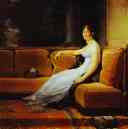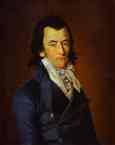The Beauharnais
 Joséphine
de Beauharnais, née Marie Joséphine Rose Tascher de la
Pagerie (1763-1814) wife of Napoleon and French
Empress, born in Martinique. In 1779, she married the Vicomte Alexandre
de Beauharnais. They had two children: son Eugène Rose de
Beauharnais (1781-1824) and daughter Hortense Eugènie Cécile
de Beauharnais (1783-1837). In 1796, two years after her husband's
execution, she married Napoleon. At Malmaison, and afterwards at the Luxembourg
and the Tuileries, she attracted to her Salon the most brilliant society
of France, and contributed considerably to the establishment of her husband's
power.
Joséphine
de Beauharnais, née Marie Joséphine Rose Tascher de la
Pagerie (1763-1814) wife of Napoleon and French
Empress, born in Martinique. In 1779, she married the Vicomte Alexandre
de Beauharnais. They had two children: son Eugène Rose de
Beauharnais (1781-1824) and daughter Hortense Eugènie Cécile
de Beauharnais (1783-1837). In 1796, two years after her husband's
execution, she married Napoleon. At Malmaison, and afterwards at the Luxembourg
and the Tuileries, she attracted to her Salon the most brilliant society
of France, and contributed considerably to the establishment of her husband's
power.
The marriage, being childless, was dissolved in 1809. Joséphine
retained the title of empress, and continued to live at Malmaison, where
she died of pneumonia while Napoleon was in exile to Elba.
See: Jacques-Louis David.
Consecration
of the Emperor Napoleon I and Coronation of the Empress Josephine in the
Cathedral of Notre-Dame de Paris on 2 December 1804.
François-Pascal-Simon Gérard.
Portrait
of Joséphine, Wife of Napoleon, at Malmaison.
Robert Lefèvre. Portrait
of Empress Joséphine.
Pierre-Paul Prud'hon. Portrait
of Empress Joséphine.
 Beauharnais,
Alexandre, Vicomte de (1760-94) French soldier, son of a governor of
Martinique, served in Louis XVI’s army in the American War of Independence.
He accepted revolutionary ideas and was president of the Constituent Assembly
in Paris in June 1791. He was given command of the army of the Rhine in
1793 but was arrested as an aristocratic ‘suspect’ and guillotined.
Beauharnais,
Alexandre, Vicomte de (1760-94) French soldier, son of a governor of
Martinique, served in Louis XVI’s army in the American War of Independence.
He accepted revolutionary ideas and was president of the Constituent Assembly
in Paris in June 1791. He was given command of the army of the Rhine in
1793 but was arrested as an aristocratic ‘suspect’ and guillotined.
In 1779, he married Joséphine Tascher de la Pagerie, afterwards
wife of Napoleon, and had two children by her: son Eugène Rose
de Beauharnais (1781-1824) and daughter Hortense Eugènie
Cécile de Beauharnais (1783-1837).
See: Unknown French painter of David’s circle. Portrait
of Alexandre de Beauharnais.
Beauharnais, Eugène Rose de (1781-1824) French soldier, son of Alexandre de Beauharnais and Joséphine. After his mother's marriage to Napoleon, he served with Napoleon in Italy and Egypt, and rapidly rose to the highest military rank. In 1805, he was made a Prince of France, and in 1805 Viceroy of Italy. In 1806, he married Princess Amalie Augusta of Bavaria, and was formally adopted by Napoleon and made heir apparent to the throne of Italy. He showed great military skill in the campaigns in Italy, Austria and Russia. After Napoleon's abdication in 1814 he retired to Bavaria, and was created Duke of Leuchtenberg.
Beauharnais, Hortense Eugènie Cécile (1783-1837), Queen of Holland, born in Paris, the daughter of Alexandre, Vicomte de Beauharnais and Joséphine. As a child she was a great favorite of her stepfather, Napoleon, and in 1802 married his brother Louis (1778-1846) King of Holland (1806-10). They had 3 sons, the youngest of which, Louis Napoleon Bonaparte, became Napoleon III. In 1810-11, Hortense was the mistress of Count Charles de Flahaut, their son became Duc de Morny. In May 1814, Hortense was created Duchesse de St. Leu by Louis XVIII at Tsar Alexander I’s request. She was a gifted artist and a composer, whose marching song, ‘Partant pour la Syrie’, became the national anthem of France's Second Empire.
Bibliography:
Chambers Biographical Dictionary. Chambers Harrap Publishers
Ltd. 1996.
World Biographical Dictionary. by V. Borodulin et al. Moscow
1998.
Die Herzen der Leuchtenberg : Geschichte einer bayerisch-napoleonischen
Familie by Adalbert. Nymphenburger.
The
Many Lives & Secret Sorrows of Josephine B. by Sandra Gulland.
Scribner, 1999.
Tales
of Passion, Tales of Woe by Sandra Gulland. Scribner, 1999.
The
Last Great Dance on Earth by Sandra Gulland. Scribner, 2000.
The
Defense of the Napoleonic Kingdom of Northern Italy, 1813-1814
by George F. Nafziger, Marco Gioannini. Praeger Pub, 2001.